
Article contents

Yep, you certainly can have a SIPP and a workplace pension. You can have as many pensions as you like. It’s often a good idea to save into both a workplace pension and a SIPP (personal pension) to help boost your total pension pot, to build a nice comfortable retirement. There’s a great strategy for saving into both below.
Keen to save more for retirement? Great idea, you’ll likely need a fairly staggering amount in your pension for a comfortable retirement these days (more on that later).
And to answer this question, yes, you can have a SIPP and a workplace pension (a pension from work), and lots of people do – it’s a great way of boosting your pension pot (and highly recommended).
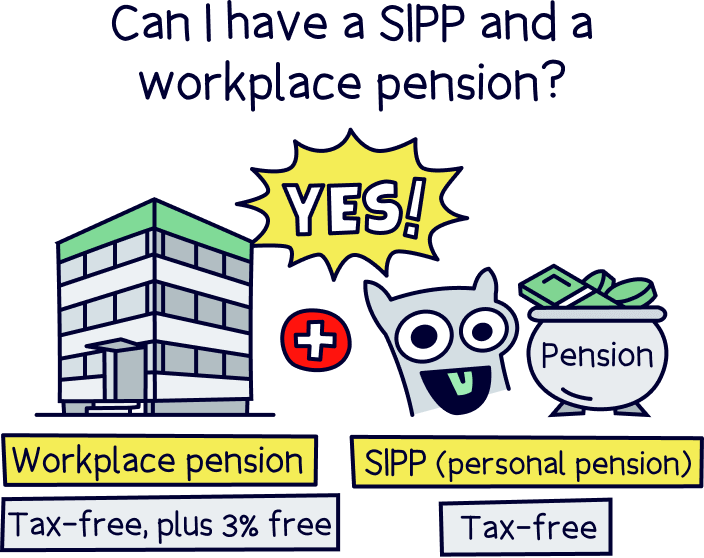
Traditionally, a SIPP was to make your own investment decisions, and you can still do that, but now you’ve got both options, leaving it to the experts, or managing it yourself.
If we've answered your question, and you’re keen to get started with a SIPP straight away, here’s our top picks for both expert-managed SIPPs and self-managed SIPPs.
We’ll cover the ins-and-outs of saving for retirement with a workplace pension and SIPP below too.
Where the experts handle things.
PensionBee tops the list, it’s easy to use, low cost and a great record of growing pensions.
Get £50 added to your pension



PensionBee is our recommended provider – they’ve thought of everything.
Their 5 star rated app (and website) makes it easy to set up and use. You can open a brand new pension, or transfer your existing pensions across (they’ll handle all the paperwork).
Simply pick from an easy to understand range of pension plans, and that’s it, the experts manage everything from there.
It’s low cost, with one simple annual fee. The customer service is excellent, and you’ll get a dedicated account manager for any questions you might have.

And, when the time comes to retire, withdrawing from your pension is easy too.
You can also use them if you're self-employed or a company director.



Moneyfarm is a great option for saving and investing (both ISAs and pensions). It's easy to use and their experts can help you with any questions or guidance you need.
They have one of the top performing investment records, and great socially responsible investing options too. Plus, you can save cash and get a high interest rate.
The fees are low, and reduce as you save more. Plus, the customer service is outstanding.

PensionBee tops the list, it’s easy to use, low cost and a great record of growing pensions.
To make your own investments within a pension.



AJ Bell is well established, with a good reputation.
It's one of the cheapest SIPPs out there (charging a low annual fee).
There's a huge range of investment options – pretty much every investment out there (including both funds and shares).
The customer service is excellent too.
Overall, it's one of the best options for a SIPP.

Get £100 - £3,000 cashback



Interactive Investor is a well established company, and very popular.
Instead of paying a percentage of the investments in your account (like other investment companies), you’ll instead pay a fixed fee per month – and it’s pretty low, starting at just £5.99 per month for a pension (SIPP).
This makes it one of the cheapest SIPP providers out there, especially if you have a fairly sizeable amount within your pension (e.g. over £30,000).
On top of that, there’s a huge range of investment options (e.g. shares and funds) – one of the largest.
It's easy to use, and the website and app are great. The customer service is excellent too.
A great choice overall.

PensionBee tops the list, it’s easy to use, low cost and a great record of growing pensions.
If you’re employed, you’ll typically have the option of a workplace pension scheme, which is a pension your employer will set up for you when you start a new job, often called auto-enrolment.
Workplace pensions are pretty great, as when you save into one, your employer has to too! If you pay in 5% of your salary per year, your employer legally has to pay in 3%, so it’s like a payrise! This free money is called employer contributions.
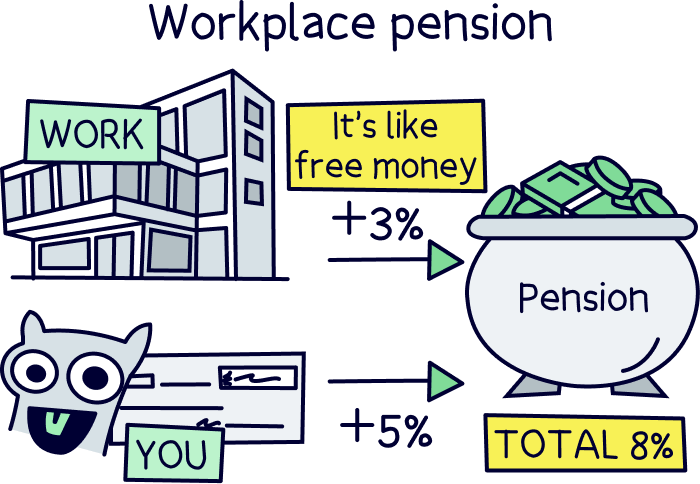
Everything is all handled for you too, your pension contributions will come directly out of your pay each month, and added to your pension pot.
With some employers, you might also have the option of ‘salary sacrifice’, which is where you can actually reduce your salary, and the difference goes into your pension pot. This can save a bit of National Insurance.
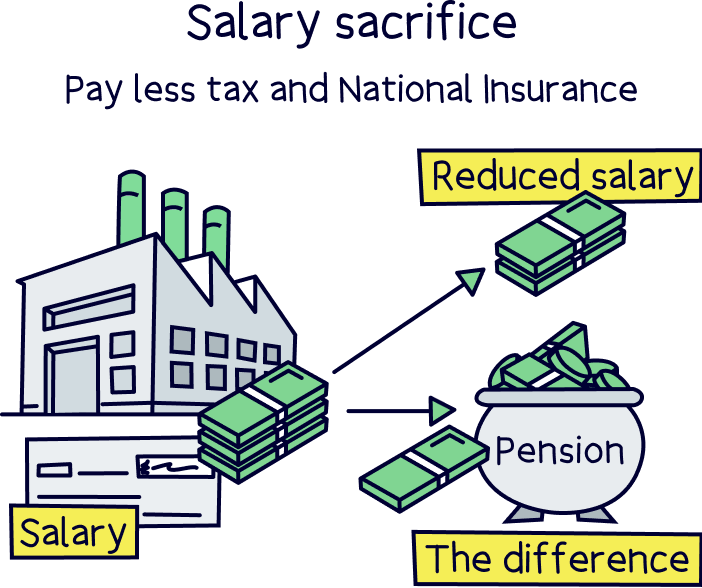
The downside to workplace pensions is that your employer decides which pension provider to use, unfortunately you don’t have a say in the matter!
Often, they simply pick any old one to get the box ticked that they offer a pension, so you don’t have the best options, or a wide range of options for where your money is saved and invested. And, things like the customer service can be pretty bad with workplace pension schemes too.
You also won’t be able to transfer your pension to another provider (company) until you leave your job.
And that’s where personal pensions, or SIPPs (self-invested personal pensions), come in.
Note: we’re talking about defined contribution pensions, which is where you add money directly into a pension pot from your salary, and this typically grows over time and has a financial value. The alternative is a defined benefit pension, which is common in public jobs, such as the NHS, where you get a guaranteed income when you retire, based on things like how long you’ve worked there and your salary.
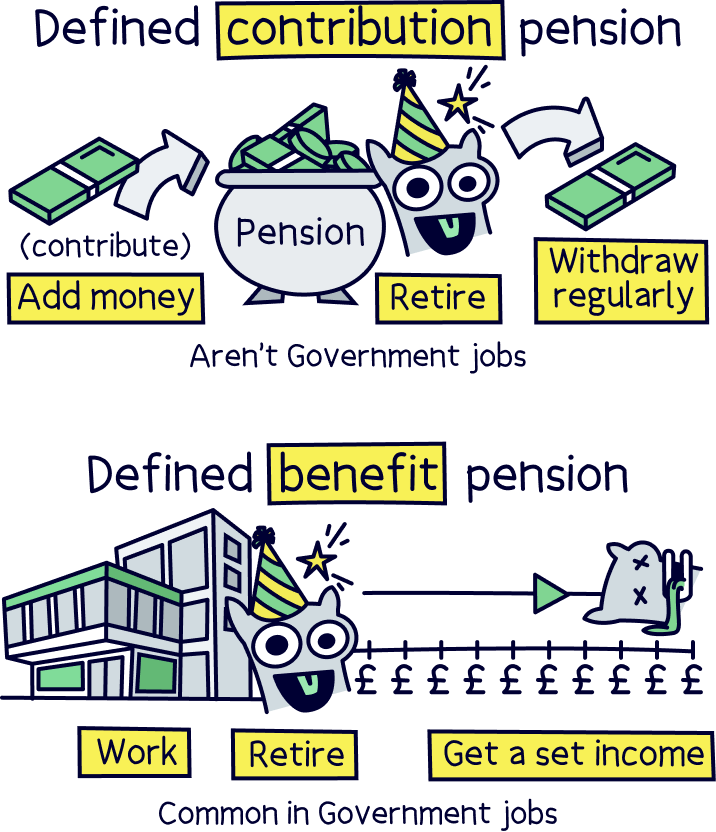
A SIPP, or self-invested personal pension, is a pension that you set up yourself, you decide how much to save, and later when to withdraw from it. You’ll decide which pension provider to use, and which investments to make… (you can simply let the experts handle things though).
Traditionally, a SIPP would allow you to pick from a huge range of investments, which you can manage as you like. These still exist, but these days, a modern SIPP will be managed by experts, and you’ll simply pick from a limited range of pension plans (investment options) – a great option for the majority of people.
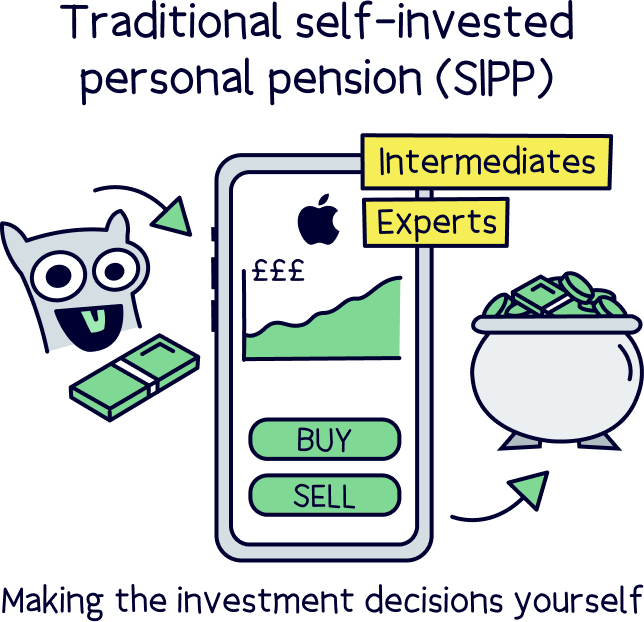
SIPPs have all the same great tax benefits of a workplace pension, except it works a bit differently…
Instead of money coming out of your salary and directly into your pension pot tax-free (from your pay), you’ll pay money into a SIPP after you’ve paid tax on your income. However, as saving into your pension is tax-free, you’ll actually get the tax back that you’ve paid, or will pay in your income.
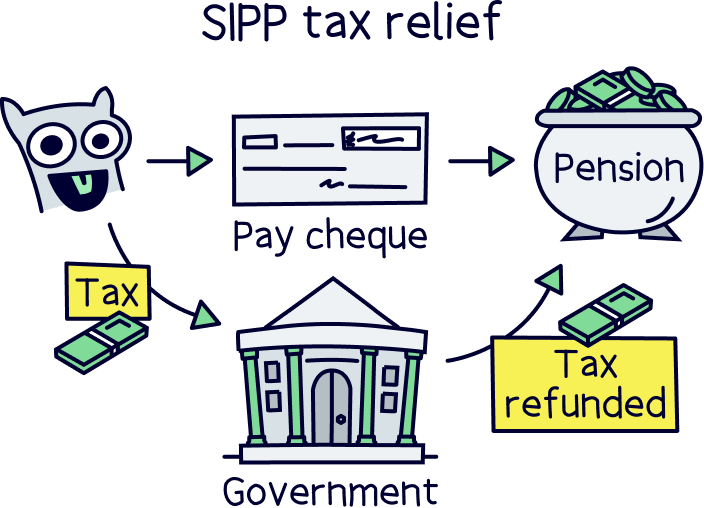
This is called tax relief, and is a 25% bonus from the government added directly into your pension pot whenever you add money. How great is that?
And if you’re a higher rate taxpayer, paying 40% tax (earning over £50,270), or an additional rate taxpayer, paying 45% tax (earning over £125,140), you can claim back some of the tax you’ve paid at those rates too, done on a Self Assessment tax return.
And with a SIPP, you get to decide which pension provider to use, so you can pick one that’s easy to use, has low fees, and a great track record of growing pensions over time – or one that lets you pick from a huge range of investment options, the choice is yours (check out our recommendations above for our top picks).
Nuts About Money tip: if you are looking to make your own investments, check out our guide to the best SIPP providers.
You’ve also got the freedom to move your SIPP to another provider in future, so you can always be with one you’re happy with – and can move over your old work pensions to your SIPP if you want to.
If you’re keen to learn more about both types of pensions, here’s our guide: workplace pensions vs private pensions.
A good plan to increase your retirement savings is to actually have both a workplace pension and a SIPP (personal pension), that way you can have the best of both worlds.
First, make the most of your workplace pension to get all the free cash from your employer that you can. That’s paying in 5% of your salary if your employer will pay in 3%.
And if they’ll contribute even more if you contribute more, do that too. This can be called ‘matching’ your contributions, and some nice employers will do this. For instance, if you pay in 7%, they might pay in 7% too.
After that, it’s normally a good idea to start saving into a personal pension (SIPP), where you have much more control over your pension savings, and can pick a great, modern pension provider that you like – perhaps one that’s easy to use and great customer service (or things like a great mobile app).
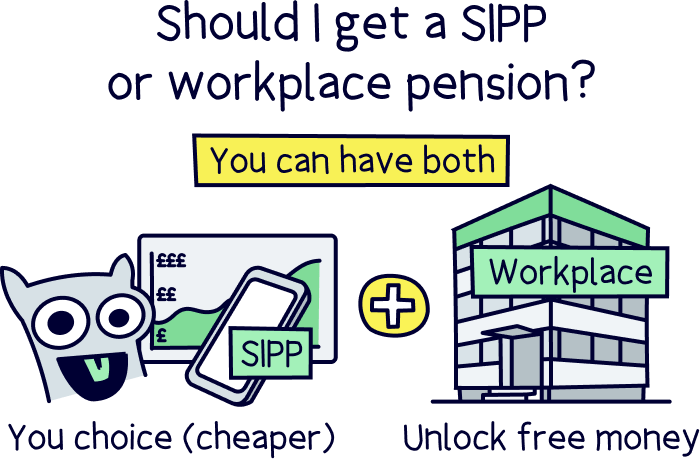
Nuts About Money tip: if you’re looking for a pension provider, here’s our guide to the best private pensions.
You can then save as much as you like tax-free every tax year (April 6th to April 5th the following year), as long as it’s below your total annual income (e.g. salary), or £60,000, whichever is lower.
And every time you get a new job, you can simply move your old workplace pension over to your SIPP, and keep everything in one place, all ready for retirement. You can do this easily after you sign up with a great new pension provider, they’ll handle the whole pension transfer process for you.
It’s a good idea to save as much as you reasonably can into your pension, as these days, you’ll need a very hefty pension pot to afford a comfortable retirement. In fact, it’s as much as £853,039 to provide a comfortable retirement income of £43,100. Yikes.
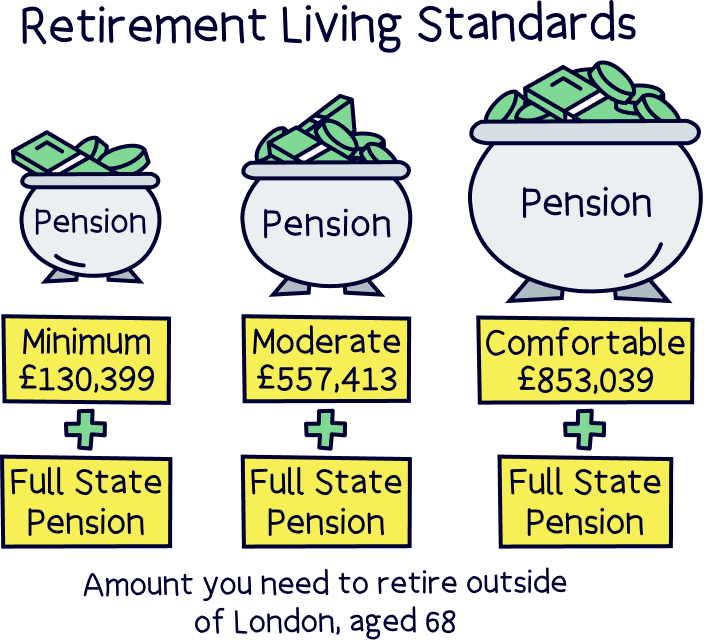
That’s in addition to receiving the State Pension too (more on that below) – so the amount you’ll need to save alongside receiving the State Pension.
There’s 3 retirement income categories we can use as guidelines for how much we need to save in our pension pot: minimum, moderate and comfortable…
These are called the Retirement Living Standards, and put together by the Pensions and Lifetime Savings Association.
Here’s how much retirement income you’ll get, and how much you’ll need in your pension pot:
Ouch. Quite a lot isn’t it? Don’t worry though, saving into both a workplace pension and a SIPP is a great strategy to build up your total pension pot to get close to a comfortable retirement – and pensions are pretty great at growing over time thanks to something called compound interest, where the money you make, begins to make money itself, and this snowballs over and over.
Let’s use an example. Say you currently have a pension pot of £10,000, and are able to save £220 per month into your pension. If your pension grows at 7% per year on average, after 25 years, you would have saved a whopping £235,470. Another 10 years after that and it would have nearly doubled to £511,294!
And just one more year after that, it would have grown by a massive £35,791 in a single year.
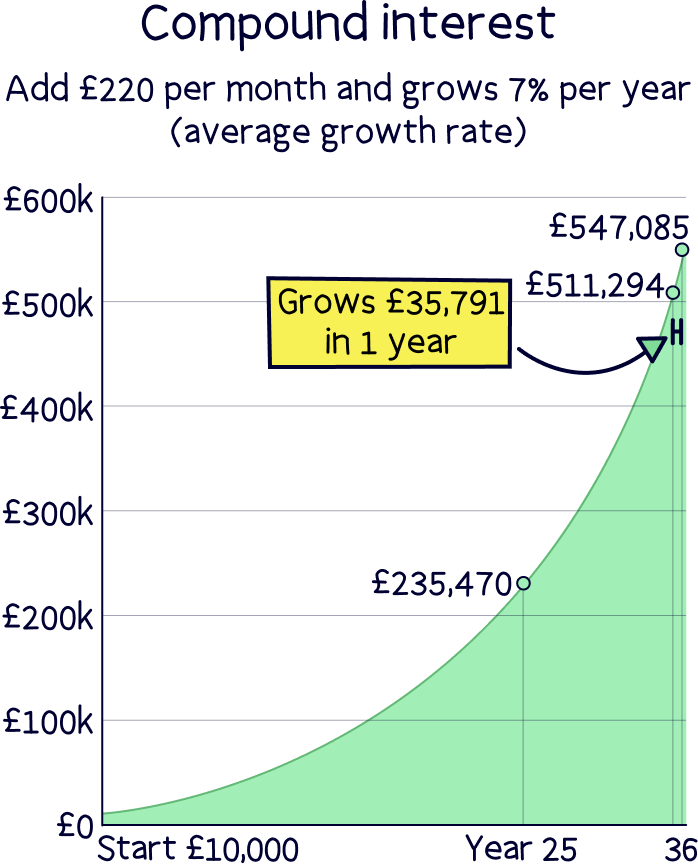
The key is starting as early as you can, and saving as much as you can (although easier said than done) – time really will have a big impact on your total pension pot, and your future self will really thank you.
Pensions are really great for retirement saving, and don’t forget you’ll get a massive 25% bonus on everything you save into a SIPP, and even more tax relief if you pay 40% or 45% tax, so your pension pot can really add up.
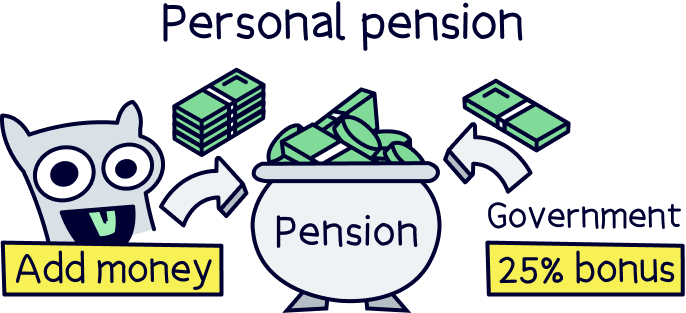
And, you can simply let the experts handle things too (growing your money over time).
Nuts About Money tip: learn more about how much you’ll need in your pension pot.
You’ll likely also get the State Pension (the government pension), when you reach State Pension age, which is currently 66.
As long as you’ve made at least 10 years worth of National Insurance contributions, you’ll get something, and 35 years for the full amount.
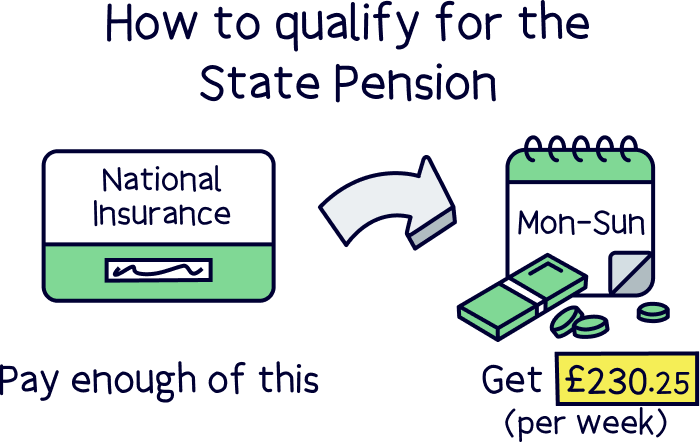
The full amount is currently £230.25 per week (£11,973 per year) – so not a lot, and not enough for the minimum retirement income (£14,400). You’ll need a large private pension alongside this for a comfortable retirement you deserve.
When you’ve built up a nice big pension pot, or reach the age you’d like to retire, you can start withdrawing from your private pension – as long as you’re over 55 (57 from 2028).
You can withdraw 25% completely tax-free, and you can take this as a tax-free lump sum if you want to.
With the remaining 75%, you might pay Income Tax on it (the same as your salary now), it depends on your total income at the time (you’ll still get the Personal Allowance of £12,570 before you have to pay any tax).
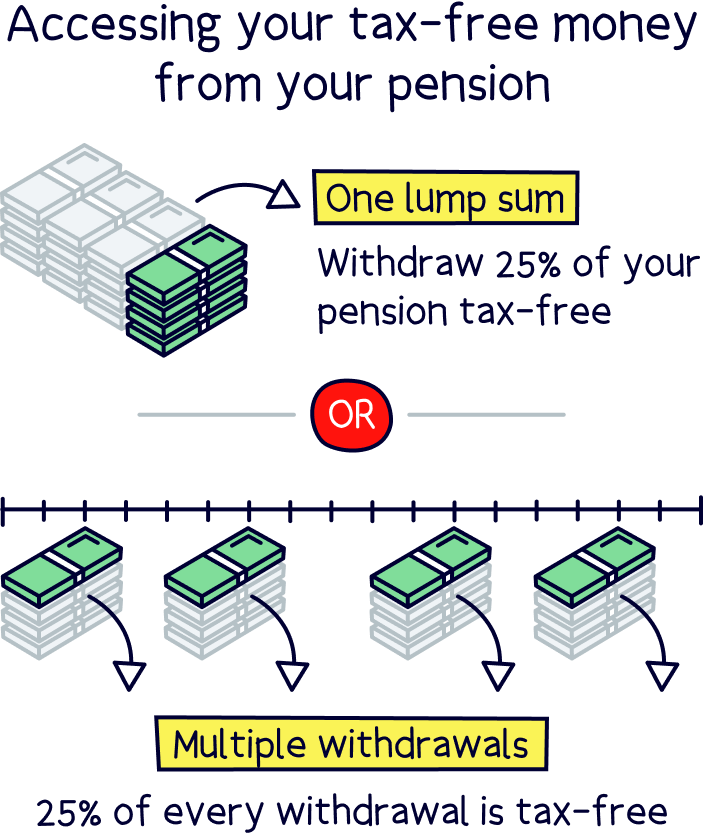
With your actual pension pot, you can either leave it where it is, and let it grow over time, while withdrawing from it as and when you like (e.g. monthly). This is called pension drawdown.
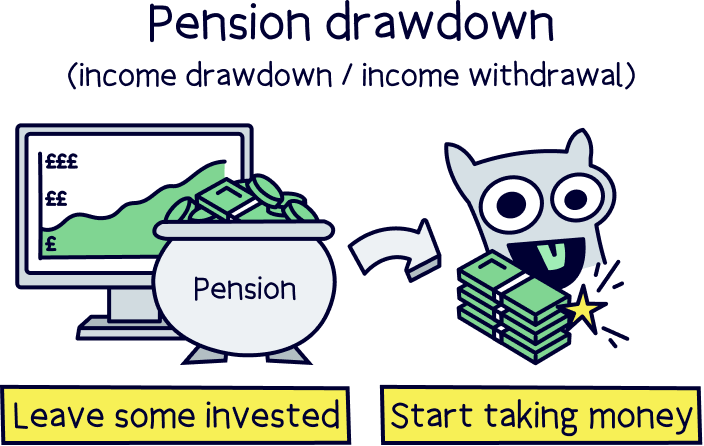
Or, you can opt for a pension annuity, which is trading in your pension pot for a guaranteed income for the rest of your life (or a set number of years, e.g. 20 years).
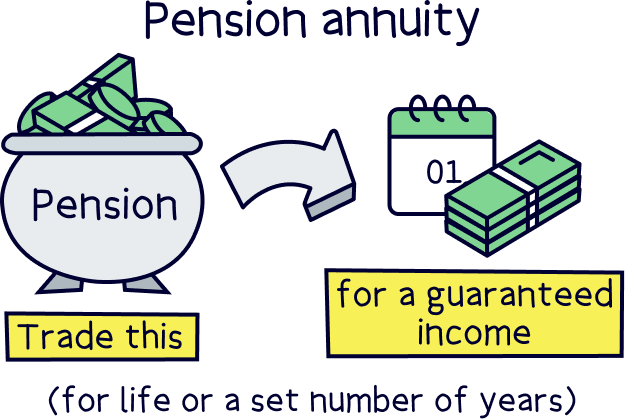
Learn more about both options with our guide: drawdown vs annuity, or if you think drawdown might be for you, here’s the best pension drawdown providers.
For more information when the time comes, get free expert advice with Pension Wise (a government scheme).
Well, there we have it. Can you have a SIPP and a workplace pension? Yep! You can have both – save away!
It’s often a good idea to have both too, and make the most of all the free money you can get from your employer with a workplace pension (when you pay in 5%, they’ll pay in 3%), and if they offer more, pay in more too.
After that, a SIPP (a personal pension) can be a great idea, giving you full control over your pension, but with all the same tax-free saving advantages. So, you can pick a pension provider that you like, perhaps one with great customer service, easy to use, managed by experts, or making your own investments – the choice is yours!
You’ll then be able to transfer your pension to another provider any time you like, and transfer all your old pensions over to SIPP too (if you want to), so all your pensions are in one place, easy to manage, and all ready for retirement.
For all the top options, check out the best private pensions. Our top pick is PensionBee¹, it’s easy to use, has low fees and a great record of growing pensions over time (managed by experts). And you’ll get £50 added to your pension for free with Nuts About Money.
Or, if you’re keen to make your own investments, check out AJ Bell¹, it’s low cost and has a huge range of investment options.
And that’s it. All the best saving for retirement.
PensionBee tops the list, it’s easy to use, low cost and a great record of growing pensions.
We’d love to hear from you, and it will help others too.
PensionBee tops the list, it’s easy to use, low cost and a great record of growing pensions.